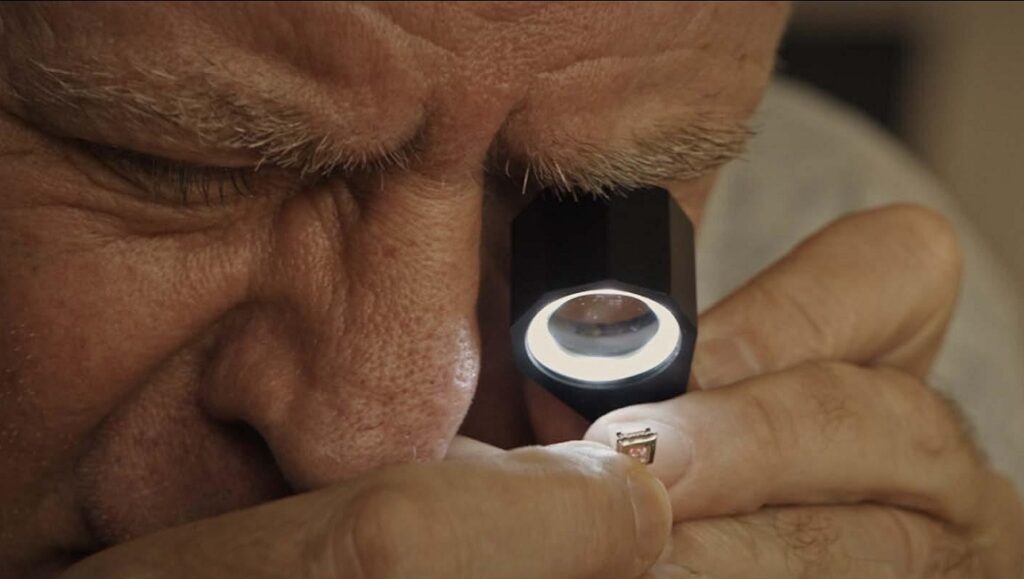Nothing Lasts Forever is a zippy but patient task-taking doc on the ills, myths, and hypocrisies of the global diamond industry.
In 1929, the Surrealist painter René Magritte cheekily told viewers that a pipe is not a pipe, inviting audiences to interrogate the difference between an object and the idea it represents. As he explained, “It’s just a representation, is it not? So if I had written on my picture ‘This is a pipe,’ I’d have been lying!” It turns out the title of his painting, “The Treachery of Images,” could be the tagline to the entire diamond industry, which rests on dazzling marketing that’s grounded in little more than economics and illusion. Jason Kohn’s zippy new documentary Nothing Lasts Forever is a playful and thought-provoking exposé on the multibillion-dollar industry, populated with entertaining interview subjects and an inquisitive score. By the time the credits roll, anyone who has been given or has considered gifting a diamond ring might be left wondering if they really are a girl’s best friend.
Kohn brings together folks from across the diamond spectrum to tell the story of why these particular crystals are so coveted and what the influx of artificial (or lab-grown) gems means for the industry. Standout interviewees include the extremely quotable historian, author, and jeweler Aja Raden; the so-called “most famous person in the Diamond District,” trader Martin Rapaport; grizzled gemologist Dusan Simic; the founder of a lab-grown gem company, John Janik; and, in perhaps the biggest coup of all, Stephen Lussier from the famously secretive and polarizing global diamond concern, De Beers.
This latter company, alternately described as a monopoly and even a cartel, has the entire industry in the palm of its bejeweled hand. Because it’s managed to hoard what seems to be almost the entirety of the world’s supply, it alone has the power to control the market, setting prices according to its own internal economics. That one-of-a-kind rock you’re so proudly displaying on your finger is identical to the millions of carats De Beers is stashing in its storerooms, Raden points out with some relish.
Not only that, these natural stones are essentially indistinguishable from their lab-grown competition, many of which are produced in China (often for industrial purposes) and sold in India, before entering the global market. It’s estimated that anywhere from 5-20% of all the diamonds in the market sprout from a lab, not the ground, and there’s even a cottage industry around faking GIA (Gemological Institute of America) certificates to further authenticate stones that no one can tell apart. It’s the industry’s most glaring open secret, but as an Indian trader shrugs off, “A thief is not a thief until they’re caught.” Conversely, a diamond is a (natural) diamond until proven otherwise. Yet, with even the FTC expanding its definition of the word to include lab-grown counterparts, why does the industry persist in wringing its hands over these artificial specimens?
The difference, Rapaport soliloquizes, is what these natural stones represent. Undying love, eternal commitment, in sickness and in health, etc…you get the idea. Along the way, he peddles some rather antiquated gender norms, though that’s not exactly surprising; in fact, he seems to have trouble separating the concept of love from the tangible reality of shiny white stones. It’s almost as if they sprang into existence as a fully-formed pair, one indistinguishable from the other. Nice try, J. Lo — love certainly does cost a thing.
Rapaport isn’t the only one guilty of a little cognitive dissonance in the face of these dazzling gems. Kohn patiently lets Lussier dig himself into a grave (or mine) as he waxes poetic about all the ways African countries have benefitted from his company’s incursions. Kohn can’t resist an over-the-top soundtrack to this particular segment, letting the irony take center stage. Raden, for her part, gleefully skewers De Beers’ romantic notion that the first diamond engagement ring in history was given to a bride-to-be as a token of love. In her telling, the ring was presented to the bride-to-be’s father as a token of commitment — to a politically advantageous alliance marriage. So much for happily ever after.


Comments are closed.